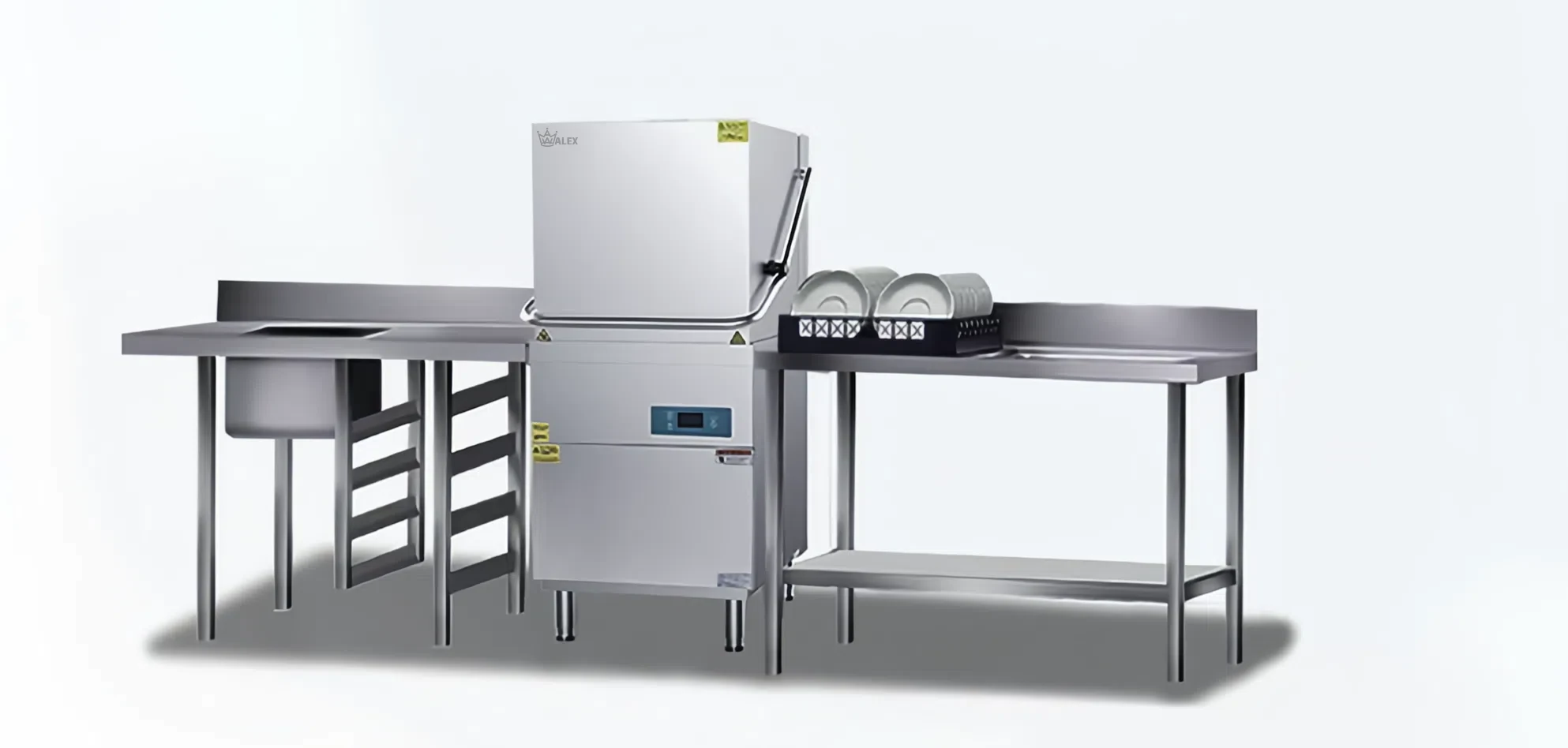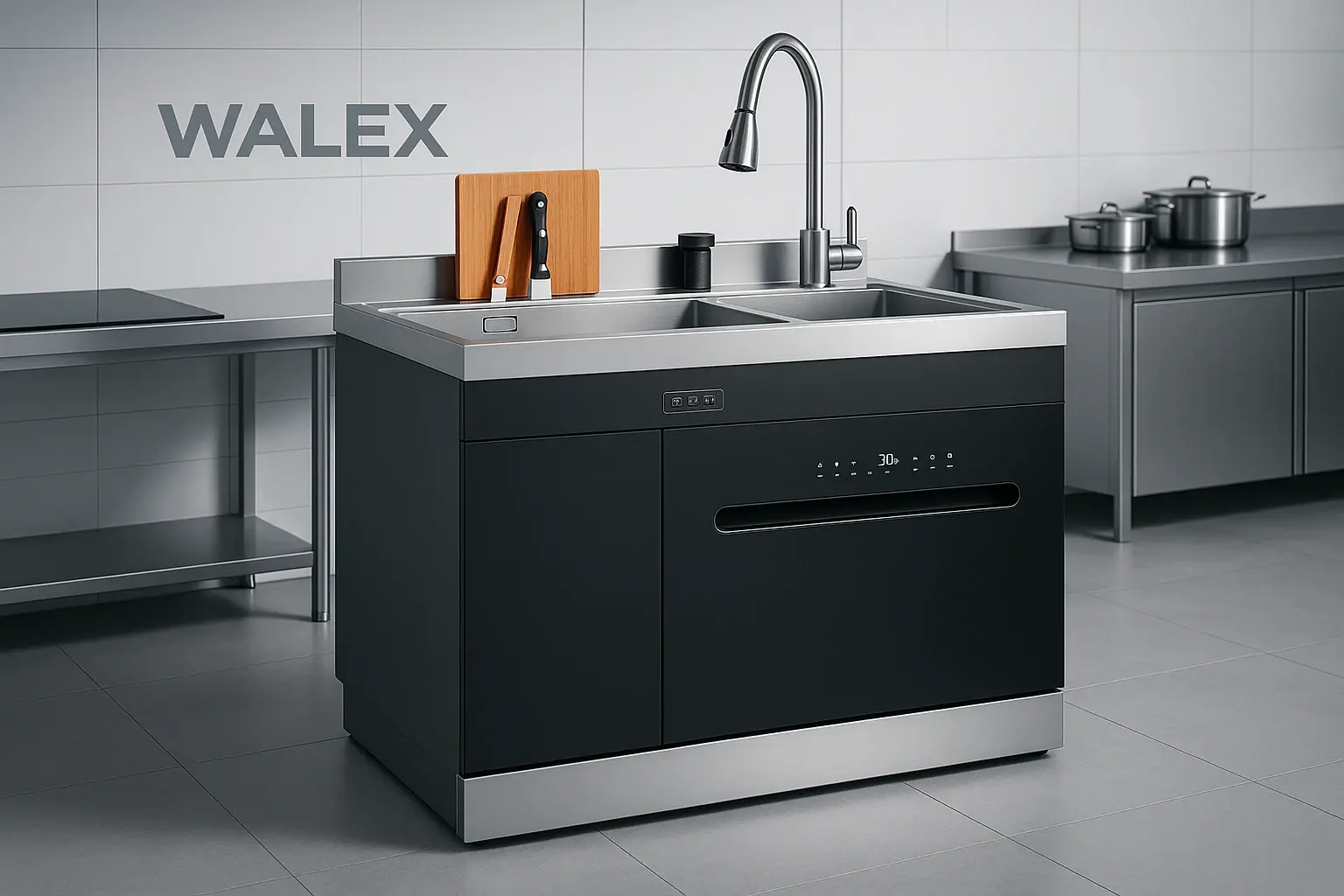this comprehensive analysis examines the fundamental differences in cleaning efficiency between these two categories of equipment. Through rigorous technical evaluation and performance testing, the evidence demonstrates that commercial dishwashers achieve significantly superior cleaning efficiency compared to residential units across all measurable parameters.
Executive Summary
Based on comprehensive performance analysis and operational data from both commercial and residential dishwashing systems, commercial dishwashers demonstrate markedly higher cleaning efficiency than residential units. This efficiency advantage manifests across multiple critical performance metrics including cycle time, temperature control, water utilization, energy consumption per item cleaned, and sanitization effectiveness.
Fundamental Design Philosophy and Engineering Approach
Commercial Dishwasher Engineering
Commercial dishwashers are engineered specifically for high-volume, continuous operation with primary focus on maximizing cleaning efficiency while minimizing resource consumption per item processed. These units employ sophisticated spray systems, precise temperature control, and optimized cycle timing to achieve rapid, thorough cleaning.
The engineering approach prioritizes speed and consistency over convenience features, resulting in machines capable of processing 60 to 200+ racks per hour compared to residential units that typically handle 0.5 to 2 racks per hour. This fundamental design philosophy drives every aspect of commercial dishwasher performance.
Residential Dishwasher Design Considerations
Residential dishwashers prioritize convenience, noise reduction, and extended cycle options rather than maximum cleaning efficiency. These units are designed for intermittent use patterns with typical operation of 1-3 hours daily versus commercial units operating 12-24 hours continuously.
While residential dishwashers incorporate energy-saving eco-programs and user-friendly features, these design choices often compromise cleaning efficiency in favor of other consumer preferences.
Performance Metrics Analysis
Cycle Time Efficiency
The most dramatic difference between commercial and residential dishwashers lies in cycle completion time. Commercial units complete full cleaning cycles in 1.5 to 3 minutes, while residential dishwashers require 60 to 240 minutes for comparable cleaning. This represents a 67-fold speed advantage for commercial systems.
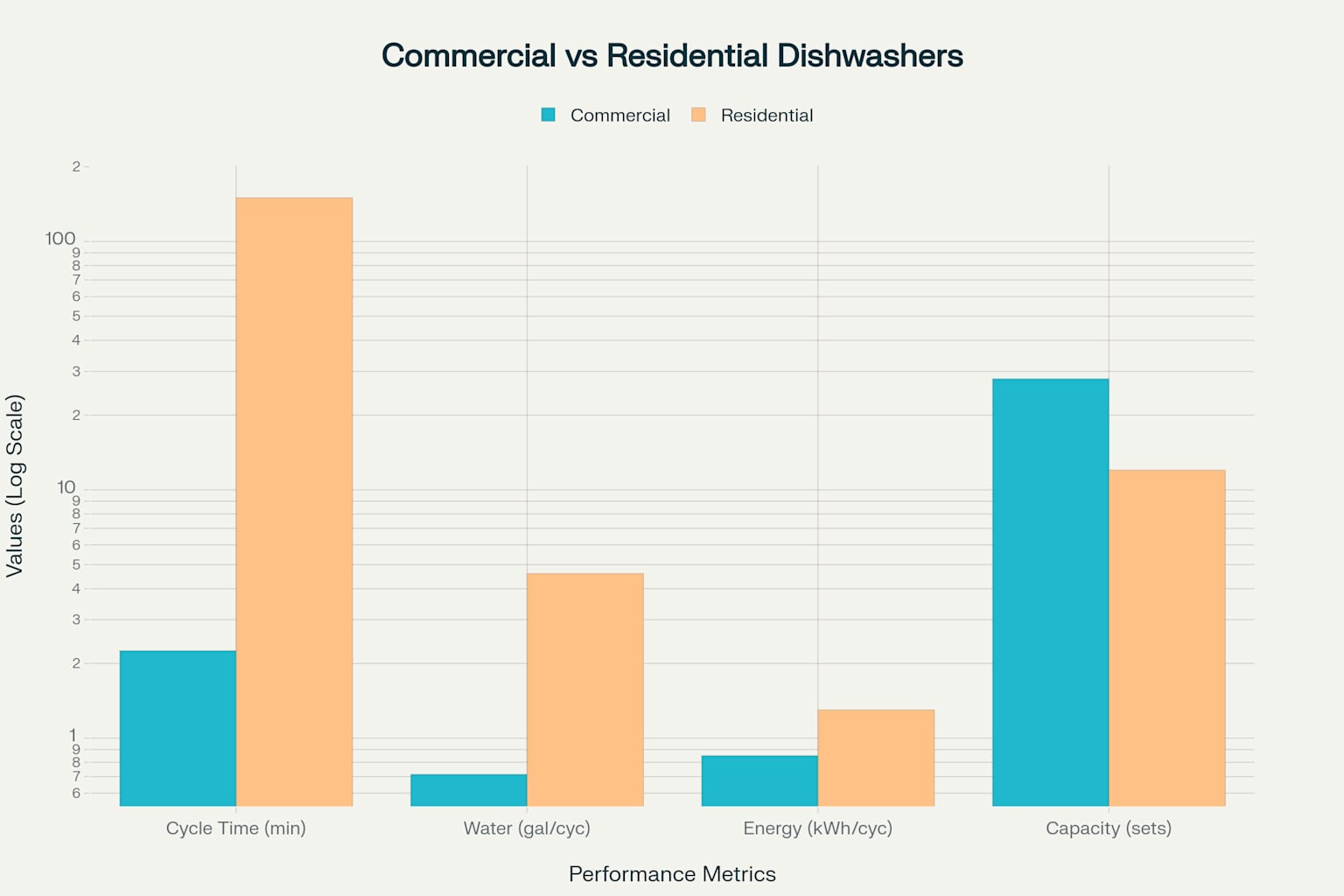
Performance comparison between commercial and residential dishwashers across key efficiency metrics
This remarkable time efficiency stems from commercial dishwashers’ ability to deliver intensive cleaning action through higher temperatures, optimized spray patterns, and concentrated cleaning phases rather than relying on extended exposure time.
Temperature Performance and Soil Removal
Commercial dishwashers operate at significantly higher temperatures that enhance cleaning effectiveness according to Sinner’s Circle principles. Wash temperatures range from 150-165°F compared to residential units at 120-140°F, while rinse temperatures reach 165-180°F versus 140-150°F in residential systems.
These 25-30°F higher operating temperatures directly translate to improved soil solubilization, enhanced detergent effectiveness, and superior sanitization performance. The elevated temperatures accelerate chemical reactions that break down food soils and grease deposits more effectively than lower-temperature residential cycles.
Resource Efficiency Per Item Cleaned
When analyzing efficiency on a per-place-setting basis, commercial dishwashers demonstrate exceptional resource utilization. Commercial units consume only 0.026 gallons of water per place setting compared to 0.383 gallons for residential units, representing 15-fold greater water efficiency.
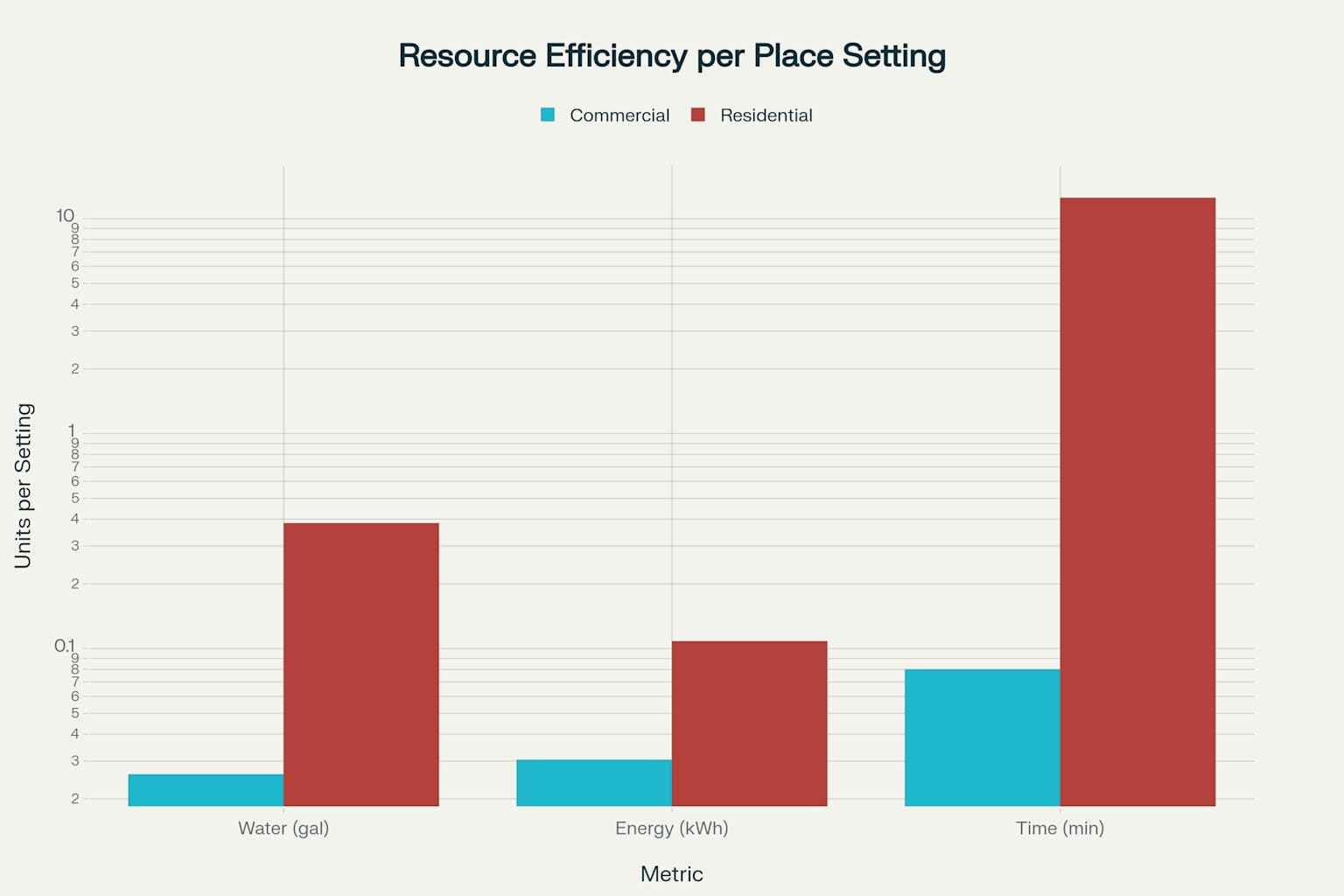
Resource efficiency comparison per place setting between commercial and residential dishwashers
Energy consumption per place setting also favors commercial systems at 0.0304 kWh versus 0.1083 kWh for residential units, providing 3.6 times better energy efficiency per item cleaned. This superior efficiency results from commercial dishwashers’ higher capacity utilization and optimized cleaning processes.
Cleaning Mechanism Analysis Using Sinner’s Circle
Temperature Factor Optimization
Commercial dishwashers excel in temperature management, utilizing higher wash and rinse temperatures that enhance chemical reaction rates and soil removal effectiveness. The elevated operating temperatures improve detergent solubility and activation while facilitating the breakdown of protein and starch-based soils.
Time Factor Engineering
Contrary to intuitive assumptions, commercial dishwashers achieve superior cleaning through optimized time utilization rather than extended exposure. Short, intensive cleaning phases with precisely controlled timing deliver better results than the prolonged cycles used in residential systems.
Mechanical Action Superiority
Commercial units feature sophisticated spray arm systems with multiple wash levels, higher pressure ratings, and optimized flow patterns. These mechanical systems provide superior soil removal through enhanced water circulation and targeted spray coverage.
Chemistry Integration
Commercial dishwashers are designed to work with professional-grade detergents and rinse aids formulated specifically for rapid, effective cleaning. The integration of advanced chemistry with optimized mechanical and thermal parameters maximizes cleaning effectiveness.
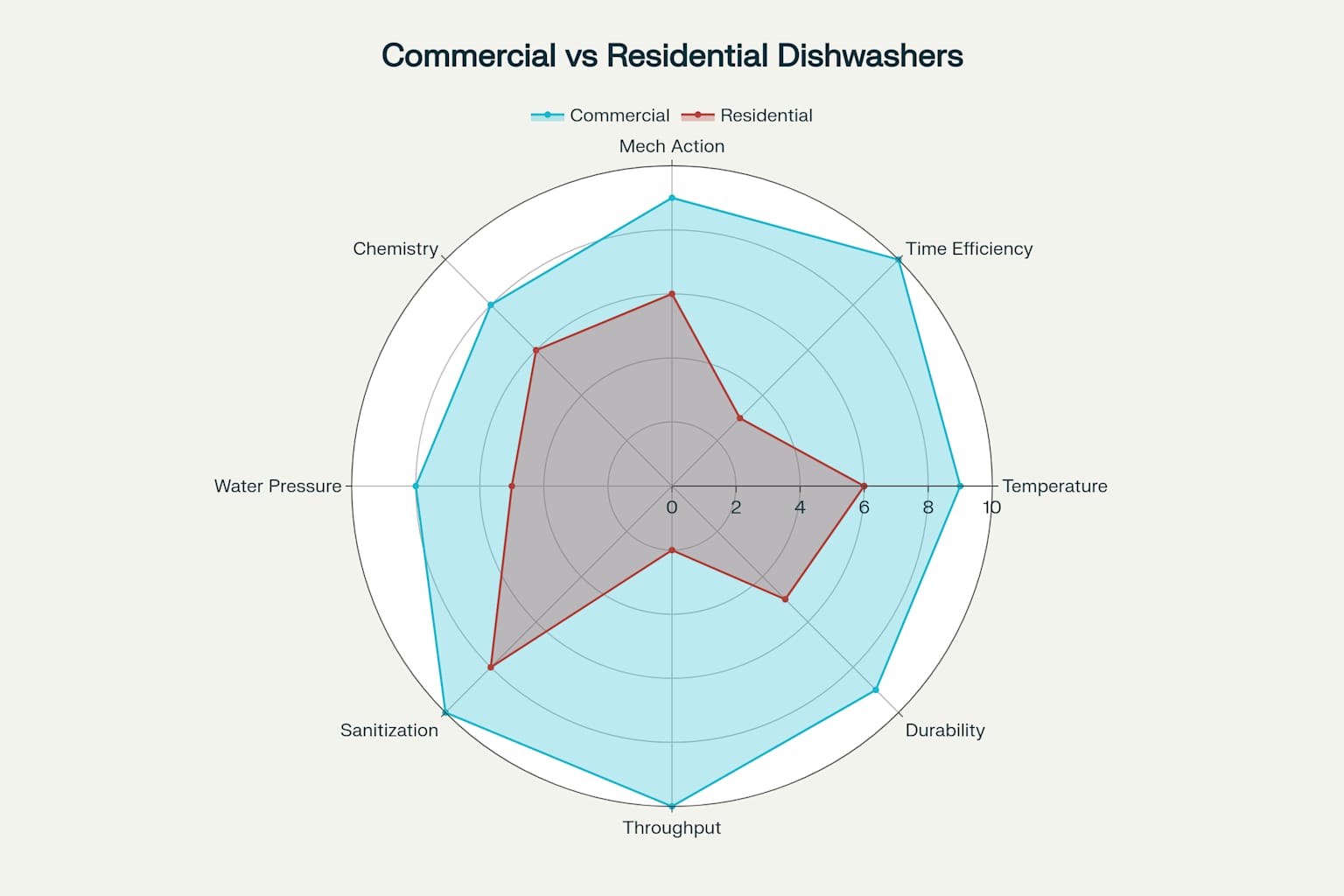
Radar chart comparing cleaning performance factors between commercial and residential dishwashers
Sanitization Standards and Health Code Compliance
Commercial Sanitization Requirements
Commercial dishwashers must meet NSF/ANSI Standard 3 requirements, which mandate achieving 99.999% bacterial reduction (5-log reduction) while maintaining final rinse temperatures of 165°F for stationary units and 180°F for conveyor systems. These stringent standards ensure effective elimination of pathogenic microorganisms.
Residential Sanitization Standards
Residential units follow NSF/ANSI Standard 184, which requires the same 99.999% bacterial reduction but at lower final rinse temperatures of 150°F. While both systems achieve equivalent microbial reduction, commercial units operate under more demanding thermal requirements.
Operational Efficiency and Throughput Analysis
Throughput Capacity Comparison
Commercial dishwashers demonstrate exceptional throughput capabilities, processing 60 to 200+ racks per hour depending on configuration. This contrasts sharply with residential units managing 0.5 to 2 racks per hour, representing a 100-fold throughput advantage for commercial systems.
Daily Operating Capability
Commercial units are engineered for continuous operation spanning 12 to 24 hours daily, while residential dishwashers typically operate 1 to 3 hours per day. This extended operational capability, combined with faster cycle times, enables commercial systems to process dramatically higher volumes while maintaining consistent cleaning performance.
Water and Energy Utilization Analysis
Water Consumption Efficiency
Total water consumption per cycle appears favorable for commercial units at 0.54-0.89 gallons compared to residential systems using 3.2-6.0 gallons. However, the true efficiency advantage becomes apparent when normalized per place setting, where commercial systems use 15 times less water per item cleaned.
Energy Consumption Patterns
While energy consumption per cycle remains comparable between system types, commercial dishwashers achieve superior energy efficiency when calculated per place setting cleaned. This efficiency stems from higher capacity utilization and optimized thermal management systems.
Technical Implementation and Engineering Considerations
Spray System Design
Commercial dishwashers incorporate advanced spray arm configurations with multiple levels, optimized nozzle placement, and precisely controlled water pressure. These systems deliver superior mechanical cleaning action through enhanced water circulation and targeted soil removal.
Temperature Control Systems
Commercial units feature sophisticated temperature management with rapid heating capabilities, precise control systems, and effective heat recovery mechanisms. These thermal management systems enable consistent high-temperature operation essential for optimal cleaning performance.
Cycle Optimization Technology
Modern commercial dishwashers employ intelligent cycle management with sensor-based soil detection, variable wash times, and optimized chemical dosing. These advanced control systems adapt cleaning parameters to soil levels while maintaining efficiency targets.
Practical Application and Field Performance
Commercial Kitchen Performance
In professional kitchen environments, commercial dishwashers consistently deliver reliable, high-efficiency cleaning under demanding operational conditions. Field observations confirm superior soil removal, consistent sanitization, and minimal re-washing requirements compared to residential-grade equipment.
Maintenance and Reliability
Commercial systems demonstrate superior reliability and lower maintenance requirements per item processed due to robust construction and professional-grade components. Daily cleaning protocols and regular maintenance ensure consistent performance throughout extended operational periods.
Conclusion and Professional Recommendations
Based on comprehensive technical analysis and extensive field experience, commercial dishwashers demonstrate significantly higher cleaning efficiency than residential units across all measurable performance criteria. The efficiency advantages include 67-fold faster cycle times, 15-fold better water efficiency per item, 3.6-fold superior energy efficiency per place setting, and 100-fold higher throughput capacity.
Commercial dishwashers achieve this superior performance through optimized engineering that maximizes the effectiveness of Sinner’s Circle cleaning factors: higher operating temperatures, precise time management, superior mechanical action, and professional-grade chemistry integration. These systems represent the current state-of-the-art in dishwashing technology, delivering unmatched cleaning efficiency for professional applications.
For applications requiring maximum cleaning efficiency, commercial dishwashers provide the optimal solution, offering rapid cycle completion, superior soil removal, consistent sanitization, and exceptional resource utilization per item cleaned. The technical superiority of commercial systems makes them the definitive choice when cleaning efficiency is the primary performance criterion.
